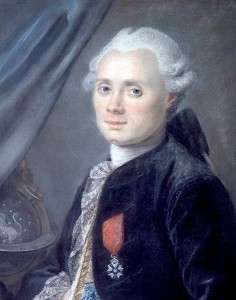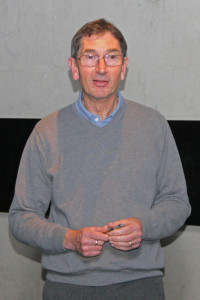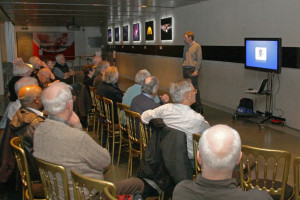March 25, 2014
Charles Messier: Le Furet des Cometes – History of Astronomy Group Meeting
Roy Hookway
Report by: Mike Dryland
Roy Hookway entertained us with a splendid talk about Charles Messier. Roy has been a Flamsteed member for over 10 years, and for 13 years was Secretary of the Thurrock Astronomy Society. Roy’s interest in Messier began when he came across ‘Messier objects’ and was told only that Messier was a French bloke who found and catalogued lots of deep-sky objects while he was searching for comets.
In fact Charles Messier was a French bloke who found and catalogued lots of deep-sky objects while he was searching for comets…. Messier’s list of objects, each with an ‘M’ number, now shows 110 items. But Roy’s talk reminded us Messier’s life was far more complicated than just observing comets and nebulae.
Charles Messier (1730 – 1817) was born in Lorraine into a family ‘of considerable wealth’. His interest in astronomy was inspired by falling out of a window and seeing a spectacular ‘6-tailed’ comet in 1743. He studied at the College Royale in Paris and in 1751 got a job with Joseph Delisle, astronomer to the French Navy, at the observatory in the Hotel de Cluny. Delisle put Charles to work initially drawing maps – his draughtsmanship was excellent. In 1757, Delisle set him to searching for Comet Halley on its expected return as predicted by Edmund Halley.
Messier did eventually find Comet Halley in late January 1759 (at first, Delisle’s calculation pointed him to the wrong place), but well after it had already been found by amateur Johann Palitzsch at Christmas 1758. For some reason, Messier went ahead anyway and announced his ‘discovery’ on April 1st 1759. This was met with some mirth and rather left Messier open to ridicule during his early career.
It may have been this experience that caused him to devote his life to comet hunting. In addition, during his search for comet Halley, Messier had documented a fuzzy object in Taurus which at first was mistaken for a comet. This was to become known as M1, the first object in his list, the Crab Nebula. From this point onwards Messier made it his business to record all such nebulae that could prove distracting to comet hunters like himself, but to him this list was always a trivial by-product of the real work – his search for new comets.
By the mid-1760s he had discovered more new comets than all previous astronomers put together and was recovering his reputation in the astronomy community both in France and internationally. He was elected a foreign member of the Royal Society in London in 1765. The ‘Great Comet’ of 1769 made him famous. He went on to discover 20 new comets (13 alone and 7 co-discoveries) and observe and document many more.
On the way his life took many twists and turns. In 1767, with Alexander-Guy Pingré, he went on a 3-month voyage on the yacht L’Aurore to test a new marine chronometer built by Pierre Le Roy. Le Roy was hard on the heels of John Harrison and Le Roy’s machine was superior in some ways to Harrison’s H4. Nevertheless, H4 was indisputably the world’s first successful marine chronometer.
Messier married in 1770, but in 1772 tragedy struck when his wife and new son both died within 11 days of the birth.
In 1774, he met and became friends and collaborator with Pierre Méchain. Méchain’s work helped to add nebulae discoveries to his catalogue. Together they worked on Messier’s list of nebulae which appeared in print in the Connaissance des Temps (the French equivalent of Britain’s Nautical Almanac) for 1783. It listed 80 objects.
In 1781, Messier came into contact with William Herschel. Working in Bath, Herschel observed a comet-like object and saw it changed position on subsequent nights. He sent his observations to Messier, the acknowledged authority on comets, to see if he could identify it. Messier’s friend, the mathematician de Saron, carried out one of the first calculations which showed Herschel’s discovery was not a comet but was a planet (now known as Uranus) in orbit around the Sun. Inspired by Messier’s catalogue, Herschel started serious work to document nebulae and had listed over 2500 by 1802.
A second tragedy struck in 1781, when Messier had a serious accident falling through a trap-door into a deep ice cellar. It was more than a year before he recovered.
Messier suffered from the old Chinese curse of ‘living in interesting times’. Indeed times became very interesting in 1789 with the start of the French Revolution. Charles survived the Terror of 1793/4 (many of his compatriots in French science did not) but lost his salaries and pensions. However in 1795/6 he followed his old mate Pierre Méchain into the new Bureau des Longitudes.
Recognition came from the new regime in 1806 when Napoleon presented Messier with the Legion d’Honneur. In return Charles dedicated to Napoleon the Great Comet discovered in 1769, the year of Napoleon’s birth. He proclaimed the comet a harbinger of the birth of the great man. This did not sit well with the astronomy community and Messier came in for another dose of criticism. (The Duke of Wellington was also born in 1769 — so much for harbingers.). The image of the decoration was then added to Messier’s formal portrait painted much earlier than 1806!
1806 was the pinnacle of Messier’s fame. After this, his eyesight and general health deteriorated and in 1815 he suffered a stroke. He died in 1817, aged 87, and was buried in the Pere Lachaise cemetery in Paris.
Charles Messier’s great legacy is, of course, his list of deep-sky objects ‘Messier Objects’. His first edition contained 45 items, and with Méchain’s help he expanded this to 103. The list was added to and organised over the years and now extends to 110 objects. He is also remembered in the name of a crater on the Moon and the asteroid ‘7359 Messier’.
Roy did great service in reminding us of the twists and turns, highs and lows, of a life and career which started in a golden age of French astronomy, survived the Terror, and bequeathed a sparkling legacy. I wonder what Charles Messier would have thought of history’s verdict.
An excellent evening.
Pictures from the Evening (by Mike Dryland):
Posted under: Flamsteed, History of Astronomy, Meeting Report










You must be logged in to post a comment.